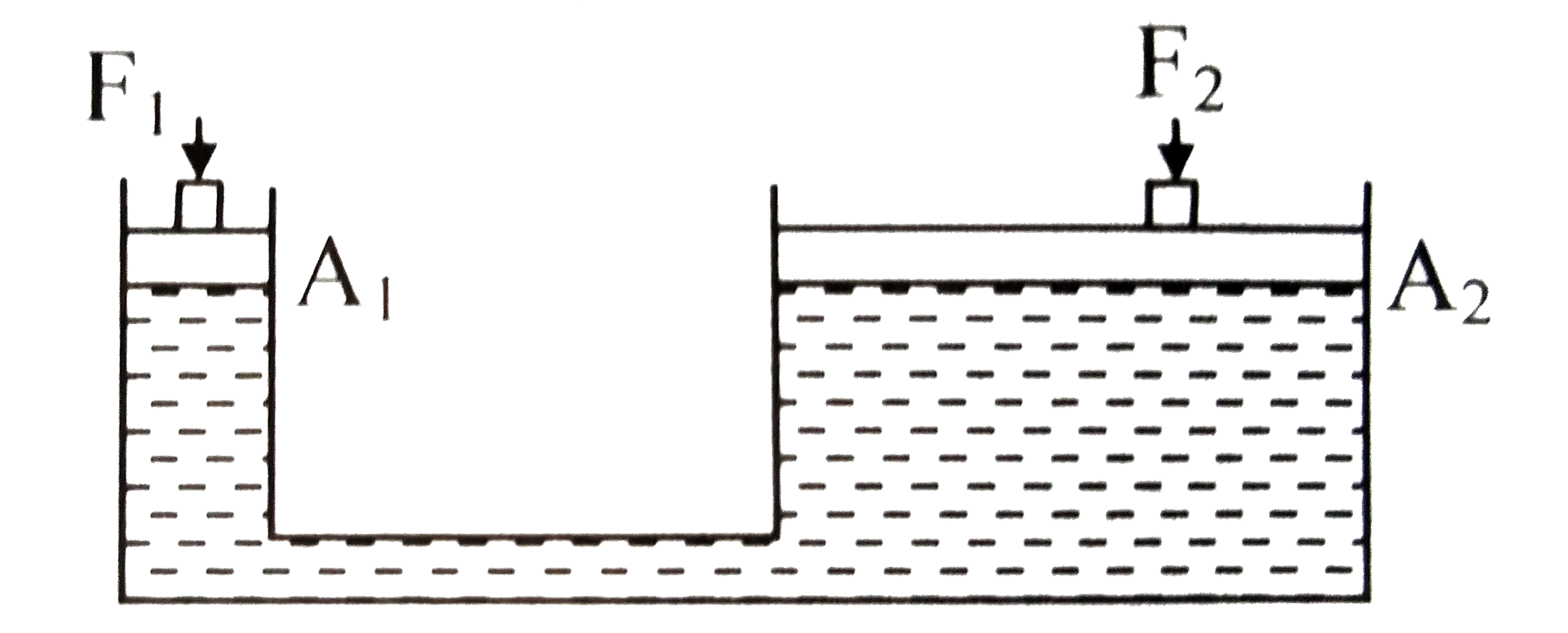Two pistons (areas A1andA2) exerting forces F1andF2 on a liquid exerts pressures P1andP2 as shown in figure. The pistons are at the same horizontal level and do not move under the influence of force, then

F2=A1A2F1
F2=F1
P2=A1A2P1
P2=P1
The correct Answer is:D
Step by step video & image solution for Two pistons (areas A_(1) and A_(2)) exerting forces F_(1) and F_(2) on a liquid exerts pressures P_(1) and P_(2) as shown in figure. The pistons are at the same horizontal level and do not move under the influence of force, then by Physics experts to help you in doubts & scoring excellent marks in Class 11 exams.
Updated on:21/07/2023Topper's Solved these Questions
- FRICTION IS SOLIDS AND LIQUIDS Book:TARGET PUBLICATIONChapter:FRICTION IS SOLIDS AND LIQUIDS Exercise:MCQ (COMPETITIVE THINKING)
Explore 97 Videos
- FRICTION IS SOLIDS AND LIQUIDS Book:TARGET PUBLICATIONChapter:FRICTION IS SOLIDS AND LIQUIDS Exercise:MCQ (EVALUATION TEST)
Explore 21 Videos
- FRICTION IS SOLIDS AND LIQUIDS Book:TARGET PUBLICATIONChapter:FRICTION IS SOLIDS AND LIQUIDS Exercise:MCQ (EVALUATION TEST)
Explore 21 Videos
- FORCE Book:TARGET PUBLICATIONChapter:FORCE Exercise:Evaluation Test
Explore 16 Videos
- MAGNETIC EFFECT OF ELECTRIC CURRENT Book:TARGET PUBLICATIONChapter:MAGNETIC EFFECT OF ELECTRIC CURRENT Exercise:Evaluation Test
Explore 12 Videos
Similar Questions
The figure shows a schematic layout of hydraulic jack. The load to be raised weighs 20,000N. The area of cross section of the two pistons are A1=50cm2 and A2=10cm2. The force (F) is applied at theend of a ligh lever bar as shown in the figure. Lenghts a and b are 4cm and 36cm respectively. Find the force (F) required to raise the load slowly.

View SolutionTwo liquids of densities p1andp2(p2=6p1) are filled up behind a square wall of side 8 m as shown in figure. The liquids have height as shown. The ratio of the forces due to these liquids exerted on upper part MN to that at the lower part NO is (Assume that the liquids are not mixing)

View Solution
Knowledge Check
From a horizontal tube with area of cross-section A1 and A2 as shosn in fiugre liquid is flowing in the level of the liauid in the two veritcal tunes is h.
 AThe volume of the liquid flowing through the tube in time is A1v1Bv2−v1=√2ghCv22−v11=2ghDThe energy per unit mass of the liquid is the same in both sections of the tube
AThe volume of the liquid flowing through the tube in time is A1v1Bv2−v1=√2ghCv22−v11=2ghDThe energy per unit mass of the liquid is the same in both sections of the tubeTwo blocks m1 and m2 are connected with a compressed spring and placed on a smooth horizontal surface as shown in figure Force constant of spring is k under the influence of forces f1 and f2 at an instant blocks move with common acceleration a0 at that instant force f2 is suddenly withdraw Mark correct option
 AInstantaneous acceleration of m1isa0−F1m1Binstantaneous acceleration of m2isa0+F2m2CInstantaneous acceleration of m1isa1=0Dinstantaneous acceleration of m2isa0=0
AInstantaneous acceleration of m1isa0−F1m1Binstantaneous acceleration of m2isa0+F2m2CInstantaneous acceleration of m1isa1=0Dinstantaneous acceleration of m2isa0=0Two bodies P and Q of masses m1 and m2 (m2>m1) are moving with velocity v1 and v2 force exerted by P on Q during the collision is
Agreater that the force exerted by Q on PBless than the force exerted by Q on PCsame as the force exerted by Q on PDsam as the force exerted by Q on P but opposite in direction
The vessel shown in the figure has two sections of area of cross - section A1andA2 .A liquid of density ρ fills both the section upto a height h in each . Consider atmospheric pressure P0 also . Find
(a) the pressure at the base of vessel .
(b) the force exerted by the liquid on the base of the vessel .
(c ) the downward force exerted by the walls of the vessel at the level B

View SolutionA smooth track in the form of a quarter-circle of radius 6 m lies in the vertical plane. A ring of weight 4(N) moves from P1 and P2 under the action of forces F1,F2 and F3. is always towards P2 under the action of forces F1,F2 and F3 Force F1 is always towards P2 and is always (20) N in maghitude, force F2 always acts hotizontally and is always (30 N) in magnitude, force F3 always acts tangentially to the track and is of magnitude (15−10s)N, where s is in metre. If the particle has speed 4m/s at P1,what will its speed be at P2?
View SolutionA piston of cross-sectional area a is used in a hydraulic press to exert a small force of magnitude f on the enclosed liquid. A connecting pipe leads to o a larger piston of cross sectional area A (Fig. 14-53). (a) What force magnitude F will the larger piston sustain without moving? (b) If the piston diameters are 3.50 cm and 60.0 cm, what force magnitude on the large piston will balance a 20.0 N force on the small piston?

View SolutionIn a hydraulic lift, F1andF2 are the force acting on the small piston and large piston having radii r1andr2 rspectively, then
View SolutionIf the blocks are moving as shown in the figure the relation between a1 , a2 and a3 will be.

View Solution

